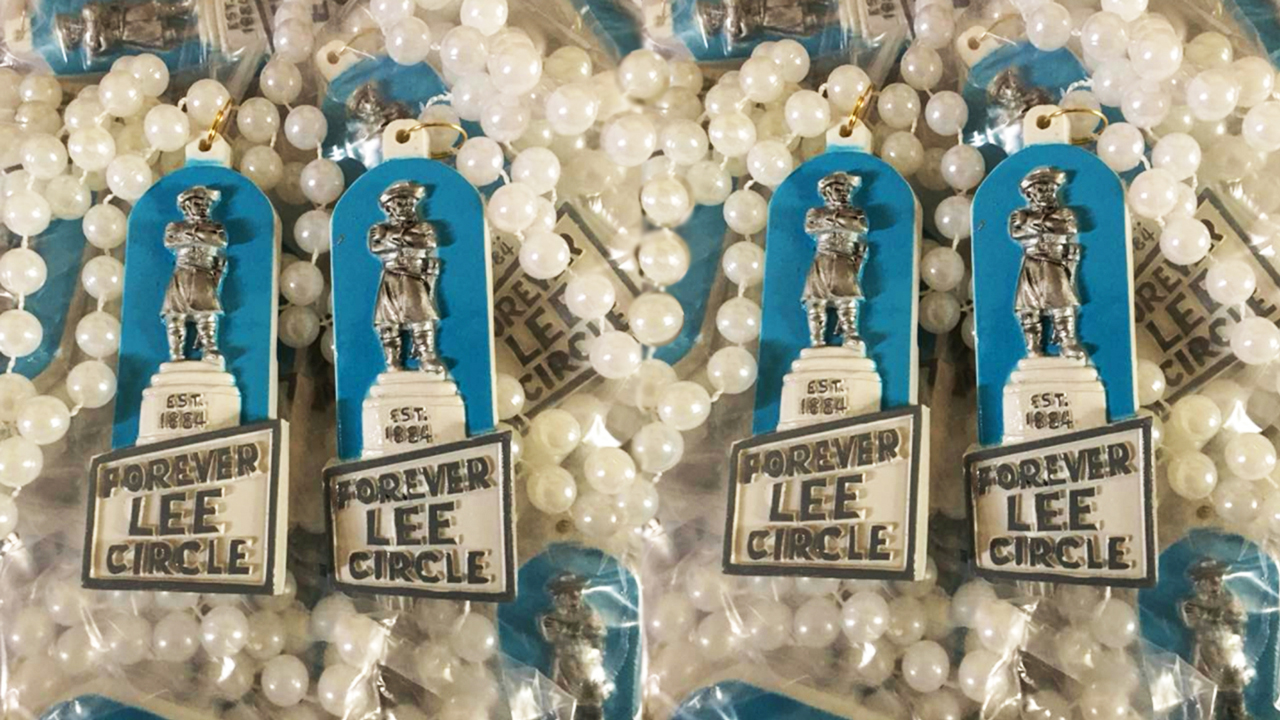Confederate Gen. Robert E. Lee wasn’t known to have spent much, if any, time in New Orleans during the Civil War.
But, the City that Care Forgot never forgot Lee, putting a monument to him up in a traffic circle in 1884. The removal of that monument earlier this year has become a point of contention, in the form of lawsuits, protests and now, Mardi Gras beads.
“Forever Lee Circle” beads are being thrown and sold as the wild party known as Fat Tuesday approaches in New Orleans.
The beads were ordered and being sold by someone who goes by “Mikas Eaux” online, but declined to give his or her real name to the Southern Poverty Law Center.
“I hope the beads serve as a conduit to take the stigma out of southern history,” “Mikas Eaux” said in an email exchange with the Southern Poverty Law Center. “People shouldn’t be afraid to be proud of their heritage.”
“Mikas Eaux” also runs a Facebook page called “Forever Lee Circle, which includes links to the New Orleans-based R.E. Lee Monumental Association, a group with the stated purpose of raising money to fund the fight to keep Confederate monuments standing.
That organization does not have a listed phone number and the owner of the website is hidden behind a privacy barrier. The group did not return emails Monday seeking comment about its connection to the beads.
An icon and an iconic place
Lee Circle, originally called Tivoli Circle, is an iconic spot in New Orleans. “Go to Lee Circle …” and “Meet me at Lee Circle …” are common phrases around Mardi Gras in New Orleans.
The traffic circle is an indication that a traveler is leaving uptown and the historic Garden District of New Orleans and nearing the famous French Quarter.
Many of the more popular and famous parades, Bacchus, Endymion and Rex, the King of Carnival, have paraded by Lee Circle to crowds of thousands.
While Lee Circle may be iconic in New Orleans, Lee himself has become a Southern symbol for the Lost Cause.
Memorials to Lee dot the Southern landscape in the form of statues, historical markers, schools, streets and parks. And, New Orleans Mayor Mitch Landrieu ordered the statue of Lee along with three other Confederate monuments taken down in 2017.
“To literally put the confederacy on a pedestal in our most prominent places of honor is an inaccurate recitation of our full past, it is an affront to our present, and it is a bad prescription for our future,” Landrieu said.
While some of the markers are gone from the Southern landscape and others are under legal challenge, none seems to have drawn a protest quite like the “Forever Lee Circle” beads being tossed and collected at Mardi Gras.
Party and protest
For all of the wild things said and written about Mardi Gras in New Orleans, it does have a long history of being used to protest and mock those in power or take on local controversies.
Krewes — the social groups that pay for and put on the giant, free party — have skewered mayors, governors, presidents and most any politician who made the news.
This year, the beads showing the statue of Lee atop a pedestal with the words “Forever Lee Circle” underneath, are just one of the newest forms of protest.
“Mikas Eaux,” who also started a GoFundMe page to fuel the fight to keep the monuments, said the throw is, in part, aimed at reminding people of the fun had at Lee Circle over the years in a city that still mourns the passing of local businesses and institutions with the phrase “Ain’t dere no more.”
“We shared many good times there as a community every carnival,” Mikas Eaux said. “I wanted to remind the community there’s been more good than bad shared at Lee Circle.”
The beads are being promoted by multiple groups, including “Save New Orleans Heritage,” and the Facebook group called “Forever Lee Circle,” which is linked to the New Orleans-based outfit called R.E. Lee Monument Association.
The group, which pledges to keep the roster of members a secret, is a non-profit pitching itself as seeking “to help us preserve accurate American history for future generations.”
It raises money to continue to fight the removal of the statues to Lee, Confederate President Jefferson Davis and Confederate Gen. P.G.T. Beauregard, the only Louisiana native or resident among the group.
Sold out
The reaction to the throws has been positive, so far.
“MIkas Eaux” said the beads, which were made available to all krewes and anyone interested in buying, sold out online.
“I’ve had people write me letters thanking me for making the bead,” “Mikas Eaux” said.
On the “Forever Lee Circle” Facebook page, Landrieu is knocked for a “disregard his constituents, ticking off his progressive checklist all to impress his radical reformist friends.”
Such comments have drawn supportive comments from native New Orleanians to people with Pepe the Frog icons as their profile pictures.
“Thank you for defending heritage. Don’t worry about what those who wish to push their agenda on us think,” wrote Chris Richard, who has multiple Pepe photos and Confederate battle flags among his Facebook posts.
Amid stories of how some Mardi Gras krewes have ties to the old Confederacy, “Mikas Eaux” said maybe the beads will get someone to study history more closely.
“The bead was a very cathartic way for those of us in the community who felt the mayor should have allowed more public input,” “Mikas Eaux” said. “He should of allowed a public vote. The bead is a way of saying goodbye to What was. It’s also a tangible way of measuring the public’s outrage of how the mayor handled this.”


